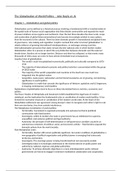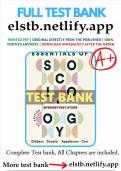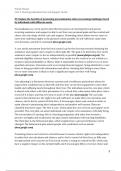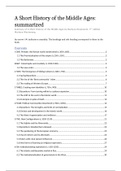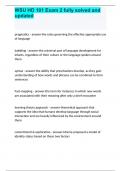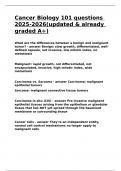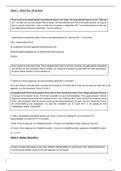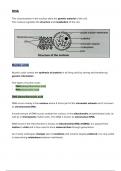Lecture 1: Research perspectives, research objective and research questions................................................. 3
Students are able to explain different research perspectives (e.g., objectivism, constructivism) ...................... 3
Students are able to explain inductive and deductive reasoning ....................................................................... 4
Students are able to formulate an objective and research questions ................................................................ 4
Lecture 2: Introduction research priorities and agendas ................................................................................. 6
Students are able to explain how research priorities are set and are able to give examples. ........................... 6
Students are able to explain what a research agenda is, what methods are used to develop a research
agenda and can give some examples................................................................................................................. 7
Lecture 3: Conceptual frameworks and operationalizing your research .......................................................... 9
Students are able to explain what a theory/ conceptual framework is ............................................................. 9
Students are able to explain why and how we use theory/ conceptual frameworks ......................................... 9
Students are able to select or develop a theory/ conceptual framework ........................................................ 10
Lecture 4: Measurement in Health Sciences and Public health part 1............................................................ 12
Students can explain the difference between validity and reliability and recognize which of these is discussed
or addressed in examples from the literature .................................................................................................. 12
Students are able to explain the main features of the COSMIN Framework.................................................... 12
Students are able to explain the important general aspects of measurement in health sciences/medicine ... 12
Lecture 5: Introduction to inter- and transdisciplinary perspective on health sciences research ................... 15
Students are able to explain what PAR, interdisciplinary and transdisciplinary approaches are ..................... 15
Students are able to explain why and when to use PAR, interdisciplinary and transdisciplinary approaches . 17
Lecture 6: Measurement in Health Sciences and Public Health part 2 ........................................................... 18
Students can explain what the different levels of measurement are and the consequences for the statistics 18
The students can explain the differences between the various types of validity (i.e., content validity, criterion
validity, construct validity) and are able to explain the basics of the methodology for testing these types of
validity according to the COSMIN Framework. They are also able to interpret the results of such tests at a
basic level. ........................................................................................................................................................ 19
The students can explain the differences between the main elements of reliability (i.e., internal consistency,
reliability, and measurement error and are able to explain the basics of the methodology for testing elements
of reliability according to the COSMIN Framework. They are also able to interpret the results of such tests at
a basic level. ..................................................................................................................................................... 20
Lecture 7: Risk factors versus prediction of risk ............................................................................................ 24
The student is able to explain the main features of observational study designs, both when studying risk
factors and when developing prediction models ............................................................................................. 24
Case-control Studies: an overview .............................................................................................................. 24
Cohort studies to assess risk factors ........................................................................................................... 25
Knowledge clip EBM explained ................................................................................................................... 26
Knowledge clip RISK .................................................................................................................................... 26
Knowledge knowing NNT ............................................................................................................................ 27
, The student is able to explain the difference between selection bias & information bias and knows how to
deal with it ....................................................................................................................................................... 29
The student is able to explain the difference between confounding & effectmodification .............................. 30
The student can identify and deal with confounding & effect modification .................................................... 31
Lecture 8: Intervention design and evaluation in Health Sciences/ Inter-and transdisciplinary research:
engagement or understanding ..................................................................................................................... 32
Students understand what monitoring and evaluation is and why it is needed .............................................. 32
Students understand different types of evaluation .......................................................................................... 33
Students understand the role of output, outcomes, and impact in evaluation research ................................. 35
LECTURE 9. Evaluations of interventions - Experimental research: (non) regular parallel design of RCT and
alternatives .................................................................................................................................................. 36
Intention to Treat ........................................................................................................................................ 36
Intention to treat analysis ........................................................................................................................... 37
Lost (to follow-up) ....................................................................................................................................... 37
You know what aspects of the study design are important to consider when you design or critically appraise
the RoB of an experimental study .................................................................................................................... 39
You know what aspects may lead to a Risk of Bias (RoB) of an RCT ................................................................ 41
You are able to explain the differences between a standard RCT, a cluster RCT and a non-inferiority RCT .... 43
You can explain the four phases of trails in the development of interventions................................................ 45
Lecture 10: Qualitative data-analyses ........................................................................................................... 46
Students are able to explain the elements of qualitative data analyses .......................................................... 46
Students can select and apply appropriate qualitative data analyses techniques ........................................... 47
Students can assess the quality of qualitative data analyses .......................................................................... 49
Lecture 11: Systematic Reviews part I .......................................................................................................... 51
Types of literature reviews ............................................................................................................................... 51
Methods of systematic reviews ........................................................................................................................ 52
GRADE as used in Cochrane: assessing the overall quality of the evidence/ certainty .................................... 55
Lecture 12: Systematic reviews part II .......................................................................................................... 57
How to interpret a forest plot .......................................................................................................................... 57
Differences ....................................................................................................................................................... 58
Meta-analyses (MA) ......................................................................................................................................... 58
Heterogeneity .................................................................................................................................................. 61
,Lecture 1: Research perspectives, research objective and research
questions
Literature: Gray, Gray Chapter 1 + 2 + 3 (‘selecting a research topic’ and ‘topics to avoid’)
Students are able to explain different research perspectives (e.g., objectivism,
constructivism)
Epistemology = study of knowledge. In other words, it is the study of what constitutes valid
knowledge. How do we know, what we know.
- Objectivism
o Reality exists independently of consciousness – in other
words there is an objective reality ‘out there’
o Connected to research perspective ‘positivism’
§ There is only one reality/truth.
§ Reality can be measured.
§ Knowledge can be formulated into laws.
o Research from a positivist perspective aims to find
generalizable truths, this is the dominant perspective
within clinical research and epidemiology.
- Constructivism
o It’s about the interaction between the person and the world.
o Truth and meaning are constructed by the person/
researcher (subjects).
o Connected to research perspective ‘interpretivism’
§ There are multiple realities.
§ Multiple, contradictory but equally valid accounts
of the world can exist.
o Whereas interpretivist approaches to research
acknowledge that any truth is socially constructed, and this
socially constructed truth is largely based on the
interpretations of the researcher and his/her participants. This perspective is
more common in the social sciences (e.g., medical anthropology).
- Subjectivism
o Subject with their own education, culture, dreams.
Connected to research perspective
- ‘Postmodernism’
o Meaning is imposed by the subject on the object.
Subject do construct meaning, but do so from within
collective unconsciousness, from dreams, from
religious beliefs, etc.
, Students are able to explain inductive and deductive reasoning
Inductive reasoning
- Whereas inductive approaches aim at collecting empirical data far
less structured and let meaning arise from data. They intend to
contribute to the development of new theory, although these
theories are often bound to the context where they emerged.
- Inductive reasoning: data collection à analyses; patterns à
hypothesis à theory
- Analyze data for emerging patterns. à develop theory
Deductive
- Deductive reasoning: theory à hypothesis à data collection à confirmation,
rejection, modification
- Deductive approaches are often very structured – researchers collect and analyze
data using clearly defined theories and concepts. Thereby aiming at verifying or
falsifying theory/ hypothesis.
- Look at your data with clear units of analysis
Students are able to formulate an objective and research questions
Research Topic à Research Objective à Research Questions
Identifying a research topic:
- Literature (books, academic and professional journals): theoretical
oriented research
- Directly from the workplace or business setting: practice-oriented
research
From topic to RO and RQ (format for an introduction)
- What is the big problem/ issue?


